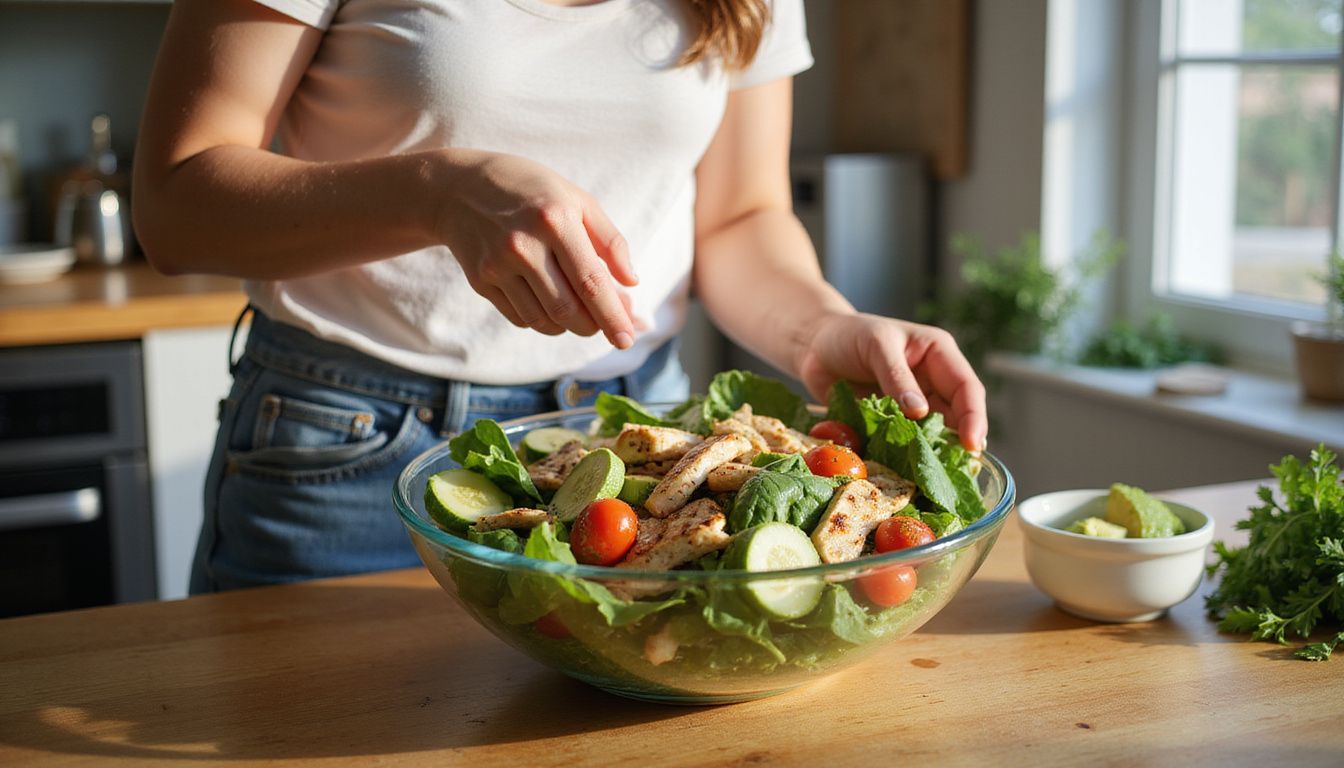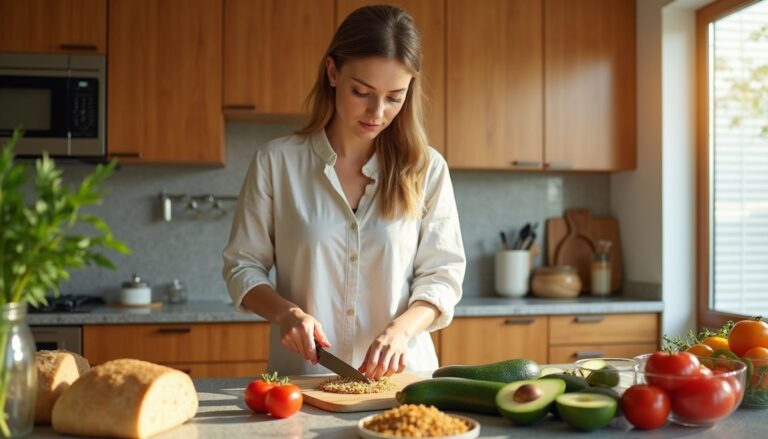Delicious Salad For Weight Loss: High-Protein Recipes To Boost Your Health
Our Nutrition Assistant AI Suite will transform your body. You will lose fat, get toned, and build muscle. Gain confidence and optimal health.
Bored, skimpy salads make it hard to stay full or meet your goals. A salad for weight loss should be balanced, satisfying, and built with smart ingredients, not just low in calories.
Research suggests a high-protein salad can support muscle health and curb hunger, which may reduce daily calorie intake. In this guide, you will find simple high-protein salad recipes, practical building tips, and common pitfalls to avoid. Use these ideas to enjoy tasty meals while working toward better health.
Keep reading for salad ideas that can boost your nutrition and energy.
Key Takeaways
- High-protein salads with grilled chicken, beans, eggs, or salmon help you stay full longer, which can support weight loss.
- Protein costs more energy to digest than carbs or fat, and 20 to 30 grams per meal helps maintain muscle.
- Lean meats, legumes like lentils or chickpeas, plus healthy fats such as avocado or nuts create balanced, filling bowls.
- Use 1 to 2 tablespoons of dressing. Choose lighter vinaigrettes to limit extra calories and sodium.
- Skipping protein or healthy fats reduces fullness and may raise cravings, making steady weight control harder.

Benefits of High-Protein Salads for Weight Loss

High-protein salads help you lose weight because they keep you full and support lean muscle. Build them with nutrient-dense items like grilled chicken, chickpeas, tofu, or salmon. These healthy salad recipes work well for a salad for lunch or dinner.
How does protein help with weight management?
Eating more protein helps you build and maintain muscle. Muscle burns more calories at rest, which supports a healthy metabolism. A salad topped with grilled chicken or salmon can keep your metabolic rate slightly higher after the meal.
Protein also supports tissue repair and immune function during weight loss. Protein-rich salads, like those topped with beans or chickpeas, make meals more satisfying. One weekday, I added black beans to a lunch bowl and stayed full until dinner without visiting the snack machine.
Including lean proteins, like turkey or chicken breast, in healthy salads increases fullness while supporting calorie control.
Choosing meals that are both protein-packed and moderate in calories helps create a gentle calorie deficit without constant hunger.
What are the benefits of high-protein, low-calorie meals?
High-protein, low-calorie meals curb hunger and support digestion. A chicken salad loaded with leafy greens or a chickpea salad with broccoli can keep you satisfied for hours.
These meals deliver steady energy with fewer calories. For example, a Salmon Caesar Salad adds omega-3 fats that support heart and brain health.
Lean proteins like tuna, grilled chicken, or tofu help manage weight over time. Fiber-rich vegetables such as kale, cucumber, arugula, and cabbage increase fullness and support metabolic health.
Swapping a creamy dressing for a vinaigrette can also reduce calories. I noticed fewer afternoon cravings after switching to a light herb vinaigrette on my green goddess salad at home.
Registered dietitians often suggest high-protein ingredients to preserve muscle during weight loss. Portion-friendly salads made with lentils or chickpeas are quick to prepare and work well for mason jar meal prep.
Using these nutrient-dense foods can make a spring salad both delicious and satisfying while supporting long-term nutrition goals.
Tips for Building a Perfect High-Protein Salad
Great salads start with a plan. Combine fiber, protein, color, and healthy fats so every bite works for you.
What is a nutrient-rich base for salads?
Choose dark leafy greens like spinach or kale as your base. They offer vitamins A, K, folate, and C in each serving. For crunch, add romaine or shredded cabbage to boost fiber and texture.
Softer greens such as arugula or spring mix keep flavors fresh and varied. Mixing greens with slaw delivers extra antioxidants and supports healthy digestion.
Building on fiber-rich bases helps control hunger while keeping calories in check.
Which lean protein sources should I add?
Grilled chicken breast, turkey, and water-packed tuna deliver high protein with less saturated fat. Salmon is another heart-friendly choice for a green salad or salmon salad, thanks to omega-3 fats.
Plant-based eaters can use chickpeas, lentils, kidney beans, or black beans. These shelf-stable legumes add protein, iron, and fiber without extra prep.
Hard-boiled eggs supply protein plus key vitamins. Cottage cheese or feta adds creaminess with fewer calories than many creamy dressings. A small handful of nuts or seeds raises satiety and adds crunch.
These lean options fit into a strawberry poppy seed salad, cucumber salad, a noodle salad with grilled chicken, or a Tex-Mex salad for easy variety.
How do healthy fats improve satiety?
After you add lean protein like grilled chicken, salmon, or eggs, include healthy fats. Avocado, chia, sunflower, flax, olives, and nuts help you stay full after meals.
These fats signal satisfaction to your brain, which lowers cravings. Olive oil and nut-based dressings make leafy greens and tomatoes taste richer without heavy sauces.
Unsaturated fats support heart health and help your body absorb fat-soluble vitamins A, D, E, and K. Spinach, kale, and citrus fruits contain these vitamins, so pairing them with healthy fats matters.
Cheese or creamy dressings add flavor but use modest portions to control calories. I felt full for hours after topping a quinoa and kale salad with pumpkin seeds and a drizzle of extra virgin olive oil.
Why include a variety of colorful vegetables?
Healthy fats pair well with a rainbow of vegetables. Bell peppers, tomatoes, carrots, cucumbers, and broccoli add volume with very few calories.
Roasted beetroot or asparagus brings bold flavor and stops menu fatigue. Bright vegetables also provide phytonutrients and antioxidants that support immunity and digestion.
Greens like kale, plus red onions and tomatoes, deliver vitamins A, C, and K. Eating many colors raises fiber, which helps control hunger between meals. Prepping roasted squash or a cabbage slaw for lunch helped me stay full through busy afternoons.
What dressings support weight loss?
Choose vinegar-based dressings like balsamic vinaigrette, or try lemon, cracked black pepper, and herbs. These options lower calories compared to rich sauces.
Greek yogurt dressings offer creamy texture with fewer calories than mayonnaise-heavy versions. Use 1 to 2 tablespoons of dressing per salad to manage fat and sodium.
Salsa or Pico de Gallo can add flavor with minimal calories. Making dressing at home helps you control salt, fat, and additives.
High-Protein Salad Recipes for Weight Loss
Use these healthy salad recipes to mix lean meat, plant-based protein, and healthy fats. Each option can stand alone as a main dish or work as a hearty side dish.
Roasted Squash & Lentil Kale Salad
Roasted squash and lentils add fiber that supports digestion and lasting fullness. A half cup of cooked lentils provides about 9 grams of protein and slow-digesting carbs for steady energy.
Kale offers a nutrient-rich base packed with vitamins A, C, and K. Roasting butternut squash brings natural sweetness without heavy dressings.
For easy meal prep, pack cooked lentils, roasted squash, and chopped kale. Add walnuts or pumpkin seeds for healthy fats. A light balsamic dressing balances the earthy flavors without many calories.
This high-protein vegan salad works for lunch or dinner and avoids empty calories from refined carbs.
Chicken & Cabbage Salad with Nuoc Cham Dressing
This 10-minute salad pairs grilled chicken breast with crunchy cabbage for a filling, low-calorie base. Nuoc Cham, a Vietnamese sauce with fish sauce, lime, chilies, and garlic, adds bold flavor without heavy fat.
Use a measured portion of dressing to manage calories. The blend of protein and fiber-rich vegetables supports fullness, which makes weight-loss goals easier to reach.
I often pack this after gym days because it keeps me full and energized. Fresh herbs like dill or cilantro add brightness and extra nutrients.
Salmon Caesar Salad with a Twist
Sometimes you want a richer taste with smart calories. A Salmon Caesar Salad delivers omega-3 fats that support heart health and steady fullness.
Use romaine or kale for a crisp base rich in vitamins. Swap bacon for grilled salmon to raise protein and cut saturated fat.
Limit Caesar dressing to 1 to 2 tablespoons. Add avocado slices or seeds for healthy fats that satisfy better than croutons alone.
If you blend dressing with Greek yogurt, you increase protein and reduce calories. This option fits well in a Mediterranean-style eating pattern.
Peanut Zucchini Noodle Salad with Grilled Chicken
Swap pasta for zucchini noodles to trim calories and add fiber. Grilled chicken breast supplies lean protein, about 31 grams per 100 grams, at fewer than 200 calories.
Bell peppers and carrots bring color, vitamin A, and vitamin C. A peanut-based dressing adds healthy fats and a savory taste.
Research suggests that pairing protein with fat can improve satiety, so this combo helps you stay full longer [1]. I prep zucchini noodles and grilled chicken in advance to save time on busy days.
A curry spice blend or roasted lentils can add warmth and crunch.
Spiced Grilled Chicken with Cauliflower “Rice” Tabbouleh
Spiced grilled chicken delivers lean protein and depth of flavor without extra oil. Using spices instead of rich sauces lowers added sugar and fat.
Cauliflower “rice” is a low-calorie swap for grains. One cup has roughly 25 calories compared to about 200 in a cup of cooked white rice.
Fresh parsley, tomatoes, and cucumber build a bright tabbouleh with antioxidants and crunch. The mix of protein and fiber helps you feel full longer.
Prep the cauliflower tabbouleh ahead for quick meals. A touch of orange zest or a spoon of cooked lentils boosts nutrients and flavor.
Chickpea Salad with Broccoli & Golden Milk-Poached Chicken
This salad combines plant and animal protein for lasting energy. Chickpeas offer about 7 grams of protein per half cup and make meal prep simple.
Broccoli adds fiber and micronutrients like vitamin C, iron, and potassium, as listed by the USDA. Poaching chicken in golden milk, a mix of turmeric, ginger, and black pepper, keeps it juicy and colorful without extra fat.
Batch-prep several portions for fast weekday meals. A touch of dijon or olive oil ties the textures together. Add pumpkin seeds for extra crunch.
Spinach & Strawberry Meal-Prep Salad
After a savory bowl, try a fresh option. Spinach provides vitamins A, K, and C, while strawberries deliver fiber and antioxidants that support healthy digestion.
Add grilled chicken or canned tuna for easy protein. A handful of walnuts or almonds brings healthy fats that improve satiety.
This salad stays crisp for several days and can be prepped in about 10 minutes. It supports weight loss without sacrificing taste.
Salmon with Curried Yogurt & Cucumber Salad
Pairing omega-3 rich salmon with a curried yogurt sauce creates a light, protein-packed meal. A 4-ounce fillet of cooked salmon provides about 23 grams of protein plus heart-friendly fats.
Use low-fat Greek yogurt, a teaspoon of curry powder, and lemon juice for a quick sauce. Cucumber adds crunch and hydration.
Cook the salmon ahead for a 10-minute lunch. This pairing kept me satisfied for hours and reduced snacking between meals.
Fresh herbs like dill or mint add aroma and extra nutrients.
Kale Salad with Quinoa & Chicken
Kale forms a nutrient-rich base with vitamins A, C, and K and plenty of fiber. Quinoa contributes plant protein and complex carbohydrates for steady energy.
Add grilled chicken breast to reach roughly 30 grams of protein per serving. This balance helps preserve muscle while you are in a calorie deficit.
Keep toppings like blue cheese or nuts on the lighter side if weight loss is the goal. The mix of greens and protein makes this bowl both hearty and flexible.
Green Goddess Salad with Chickpeas
Chickpeas give this Green Goddess salad a budget-friendly protein boost, about 15 grams per cup, plus fiber for fullness. Use mixed greens for variety and micronutrients like vitamin K and vitamin C.
Make the dressing with yogurt instead of mayonnaise for a creamy but lighter sauce. Fresh herbs such as parsley and chives add flavor without extra fat.
Sprinkle chopped nuts for texture or add blueberries for color and antioxidants. Regular intake of protein-rich legumes may support modest weight changes in calorie-controlled plans.
Tuna, White Bean & Dill Salad
Water-packed tuna supplies lean protein that supports muscle recovery. White beans add fiber and plant protein for extra staying power.
Dill and a lemon dressing deliver bold flavor with few calories. Pack this salad for work, but keep it chilled in an insulated bag for food safety.
I once took this on a warm-weather hike with an ice pack. The beans and tuna kept me full for hours without weighing me down.
Crunchy Chicken & Mango Salad
Grilled chicken offers high-quality protein for fullness and muscle repair. Mango adds natural sweetness, vitamin C, and fiber.
Shredded cabbage or carrots build crunch and volume. A light vinegar dressing ties everything together without many calories.
Add arugula for peppery flavor and more antioxidants. A sprinkle of nuts or seeds can round out healthy fats.
Strawberry Poppy Seed Salad with Chicken
Strawberries provide antioxidants and gentle sweetness. Sliced grilled chicken adds lean protein that helps you stay full.
Poppy seeds contribute healthy fats and a pleasant crunch. Use crisp romaine or mixed greens to keep calories low and texture high.
Top with blueberries for an extra antioxidant lift. Toss with a simple poppy seed dressing, then pack for busy weekdays.
Why Choose High-Protein Salads?
High-protein salads give steady energy and lasting fullness, which makes day-to-day eating easier.
How do high-protein salads boost metabolism?
Protein requires more energy to digest than carbs or fat. That means your body burns slightly more calories after a protein-rich meal. Lean proteins like grilled chicken or turkey can support this effect.
Salmon also brings omega-3 fats that may aid metabolic health. Keeping or gaining muscle matters because muscle burns more calories at rest.
High-protein salads help protect muscle during weight loss. Add berries like blueberries for antioxidants without many calories.
Can they enhance muscle recovery and retention?
Protein after exercise supports muscle repair. Lean meats, fish, legumes, and dairy provide essential amino acids, the building blocks of muscle.
Pairing protein with healthy carbs, such as fruit or quinoa, restores energy and supports cell function. Many studies suggest 20 to 30 grams of protein per meal helps retention and recovery.
These meals also reduce the risk of muscle loss during a calorie deficit.
Why do they keep you full longer?
Protein and fiber slow digestion, which extends fullness and reduces snacking. Healthy fats from avocado, olive oil, or seeds add satisfaction and control cravings.
A balanced salad with grilled chicken, chickpeas, and broccoli can keep hunger in check for hours. Fiber from beans and carrots adds bulk so your stomach feels fuller.
Research shows that meals with protein, fiber, and healthy fats often lead to fewer calories eaten later in the day.
How do they support overall health and immunity?
Mixing many vegetables delivers a wide range of nutrients. Greens like kale, spinach, and broccoli supply vitamins A, K, C, and folate that help your immune system.
Adding antioxidant-rich fruits such as blueberries can lower inflammation and protect cells. Healthy fats from avocado, nuts, and seeds help your body absorb fat-soluble vitamins.
Lean proteins like grilled chicken or chickpeas round out the bowl, supporting muscle repair and general wellness.
High-Protein Ingredients to Include in Your Salads
Choosing the right proteins and fats makes your healthy salad more satisfying and nutritious.
What are good grilled protein options?
Grilled chicken breast is a standout. A 4-ounce portion has about 27 grams of protein and roughly 140 calories. Grilled turkey breast offers similar benefits with little saturated fat.
Seared or grilled salmon supplies high-quality protein and omega-3 fats. A 3-ounce portion has nearly 22 grams of protein and includes vitamin D.
I often add diced grilled chicken or flaked salmon to greens for a lunch that keeps me full until dinner.
Which plant-based proteins work well?
Beans such as chickpeas, kidney beans, black beans, and lentils bring protein and fiber. One cup of cooked lentils contains about 18 grams of protein, based on USDA data.
Tofu adds a satisfying texture and roughly 8 grams of protein per 3-ounce serving. Quinoa offers complete plant protein at around 8 grams per cup plus complex carbs for steady energy.
Adding quinoa or chickpeas to a lunch salad can help you avoid afternoon snacks.
What dairy proteins are healthy choices?
Low-fat cottage cheese gives about 14 grams of protein per half cup with fewer calories than full-fat types. Fold it into salads for creaminess.
Greek yogurt makes a protein-rich base for creamy dressings, about 10 grams per 100 grams. Hard-boiled eggs add around 6 grams of protein each and are easy to slice over greens.
Feta provides strong flavor and about 4 grams of protein per ounce. Use small amounts to manage calories.
Which healthy fats should I add?
Add avocado for creamy texture and unsaturated fats. Half an avocado has about 15 grams of fat plus fiber and potassium.
Sprinkle nuts or seeds for crunch and satiety. A 1-ounce serving of almonds, walnuts, pistachios, or pepitas has roughly 14 to 18 grams of fat.
Olives and extra virgin olive oil supply monounsaturated fats that support heart health. Two tablespoons of olive oil contain about 27 grams of these fats, so measure carefully.
Adding olives to roasted squash salads makes each bite satisfying and may help you feel full longer.
Common Mistakes to Avoid in Weight-Loss Salads
Small shifts in how you build and dress your salad can make a big difference over time.
Why avoid overloading dressings and toppings?
Limit dressing to 1 to 2 tablespoons. Extra dressing can add hundreds of calories fast. Creamy dressings like ranch or Caesar tend to be higher in fat and calories. Lighter vinaigrettes support weight goals better.
Heavy cheese, bacon, and croutons raise calories quickly. Portion control matters, even with nutritious salads.
For example, a quarter cup of shredded cheese, two tablespoons of bacon bits, and three tablespoons of creamy dressing may add more than 300 calories. Keeping toppings modest helps manage calories without losing flavor.
What happens if you skip protein or healthy fats?
Skipping protein can leave you hungry soon after eating. You may snack more later, which raises total calories.
Healthy fats help your body absorb vitamins A, D, E, and K. Without them, nutrient intake drops and cravings can rise.
Protein and healthy fats work together to keep energy steady and hunger controlled.
Why not rely only on iceberg lettuce?
Iceberg lettuce has fewer nutrients than darker greens like spinach or kale. Using only iceberg lowers your intake of vitamins A, K, C, and folate.
Mix in arugula, kale, or romaine to increase fiber and micronutrients. A variety of greens also adds more flavor and texture, which often improves satisfaction.
Combining several greens makes your salad more nutrient dense and better aligned with weight-loss goals.
Quick and Easy Salad Prep Tips
A little prep time sets you up for fast, high-protein salads during busy weeks.
How can I meal prep salads for busy days?
Cook grains like quinoa early in the week and let them cool. Portion proteins such as grilled chicken or beans ahead of time. Keep a few canned legumes in the pantry for quick add-ins.
Buy pre-washed greens and store them with a paper towel to absorb moisture. Chop vegetables like carrots, bell peppers, and cucumbers in advance. Store each item separately in airtight containers.
Build salads in jars for grab-and-go meals. Place dressing at the bottom and greens at the top to avoid sogginess. Rotate proteins each week to prevent boredom, such as chickpeas one week and salmon the next.
What are the best ways to store ingredients for freshness?
Use airtight containers for chopped vegetables and greens. Keep dressing separate and add it right before eating.
Refrigerate cooked proteins and grains and use them within several days. Portion containers make it easier to track balanced amounts and stay consistent.
These steps keep textures crisp and flavors bright, which makes healthy choices simpler.
How do I control portions for balanced meals?
Plate your salad instead of eating from a large container. Measuring helps. Use cups or a food scale to portion protein, grains, and fats.
Limit dressing to one or two tablespoons. Choose single-serve packs for nuts and seeds to prevent overscooping.
Studies suggest mindful plating supports steady portion sizes and helps with weight management.
Conclusion
High-protein salads are a practical way to support your weight loss journey. These bowls increase fullness, aid metabolism, and help protect muscle. Build them with lean proteins, leafy greens, colorful vegetables, and healthy fats to manage calories without losing taste.
Make simple dressings at home to control sodium and added sugar. Plan a few healthy salad recipes each week and prep ingredients in advance. If you have a medical condition or unique needs, speak with a registered dietitian for personal guidance. With a bit of planning, every high-protein salad can be both nutritious and satisfying, which makes long-term success easier.
[1] Harvard T.H. Chan School of Public Health: “The Nutrition Source – Protein”.
FAQs
1. What makes a salad high in protein and good for weight loss?
A salad is high in protein when it includes foods like grilled chicken, lentils, cottage cheese, or hard-boiled eggs. These foods help you feel full longer and support muscle health. Research shows that higher protein intake can help reduce hunger and support weight loss. For example, a study in the American Journal of Clinical Nutrition found that people who ate more protein lost more body fat than those who ate less. Including protein-rich foods in your salad can help you manage your weight more effectively.
2. How many calories and protein should a weight loss salad contain?
A weight loss salad should have enough protein to keep you full and enough calories to give you energy. Most experts suggest 15 to 30 grams of protein per meal for adults. A typical high-protein salad might have 300 to 400 calories and 20 grams of protein. Here is a simple table for reference:
Nutrient | Amount per Salad
—————–|—————–
Calories | 300 to 400
Protein (grams)| 20
Fiber (grams)| 8 to 12
These numbers can help you plan your meals and track your progress.
3. What are some easy high-protein salad recipes for weight loss?
Some easy recipes include a spinach salad with grilled turkey and chickpeas, a mixed greens salad with cottage cheese and sunflower seeds, or a bean salad with kidney beans and diced eggs. I often prepare a salad with leafy greens, roasted chicken, and pumpkin seeds. This meal keeps me full and gives me energy throughout the day. These recipes are simple to make and use common ingredients.
4. Can high-protein salads help improve overall health?
High-protein salads can support weight loss and also offer other health benefits. They provide important nutrients like vitamins, minerals, and fiber that your body needs. Studies show that eating more protein may help lower blood pressure and maintain healthy muscles as you age. Choosing a variety of colorful vegetables with lean proteins in your salad can boost both your nutrition and well-being.
Summary: High-protein salads are effective for weight loss because they keep you full, provide key nutrients, and are easy to prepare. Including foods like chicken, beans, or cottage cheese helps increase the protein content while supporting overall health goals.







